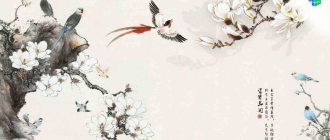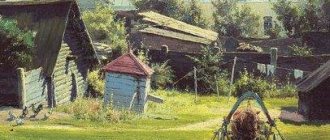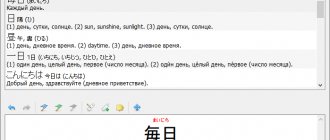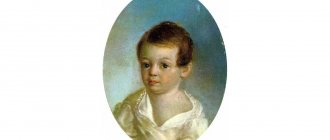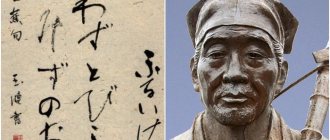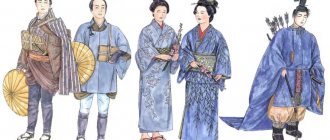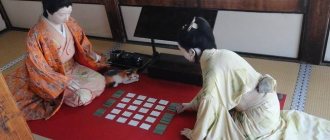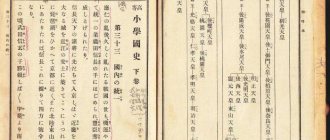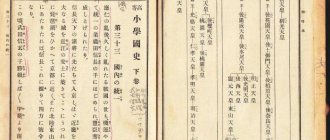Japanese poetry
Japanese poetry
In the treasury of world literature, Japanese poetry stands apart, a unique and very interesting phenomenon. The genre of Japanese poetry is haiku, an unrhymed tercet of seventeen syllables. This has already been discussed in previous articles. The distinctive features of haiku include: free presentation, simplicity and elegance of poetic language. Haiku originates from tanka, translated from Japanese as a short song. Tanka is an unrhymed five-line poem that consists of 31 syllables. The first and third lines have five syllables each, the second, fourth and fifth lines have seven syllables each. In some cases, there is also a sixth line, which is a strengthened version of the fifth. The whole poem or the component poems of the thangka cannot be divided into equal halves. Thangka is an ancient poetic form, the structure of which allows for the possibility of improvisation and improvement of skill. As a poetic form, tanka is conservative, but this does not at all interfere with poetic and artistic development.
Japanese poetry is figurative and symbolic, full of hints and halftones. Symbols have special meaning for the Japanese.
Japanese poems make you rise above the hustle and bustle of everyday life and think about the beauty of the world around you. Every moment of life is unique and inimitable, but in order to enjoy it, you need to be able to see the diversity and splendor that surrounds a person.
Japanese poetry developed over several centuries. In ancient Japanese chronicles, songs were found that were created in the 6th century or even earlier, during the period of the conquest of Japan by the distant ancestors of modern Japanese. In the 7th century, the birth and formation of the Japanese monarchy took place.
Poetic works dating back to the 4th–7th centuries are not characterized by contemplation, admiration for the beauty of nature, flowers, and birds. In those days, Japanese songs were distinguished by the glorification of belligerence, courage, and bravery. The ancient Japanese were fierce, tireless warriors who valued strength and courage. But in their life there were not only battles, but also festivities, at which cheerful and solemn songs were sung.
The founder of the monarchy in Japan was Emperor Jimmu-tenno (5th century BC). It is believed that it was he who created a lot of literary poetic works.
Printing in Japan dates back to the 8th century, by which time Japanese poetry had already fully developed as a genre, acquiring its own unique features that make it recognizable and memorable. Until the 19th century, Japanese poetry developed in its own way, only then did European influence begin to be felt.
Japanese literature is divided into periods depending on the location of the imperial residence. This was due to the fact that in ancient times the location of the emperor's residence changed when a new monarch took the throne.
The contender for the throne always lived far from the reigning monarch. And, accordingly, when after the death of the emperor power passed to the heir, the location of the ruler’s residence changed.
Only in 710 was the capital established in Nara, after which the residences of the monarchs remained in the same place. However, after some time it became clear that the location of the capital was not very convenient from a political point of view, and the imperial residence was moved to Nagaoka, where it remained until 794, then to Kyoto.
The name of the Nara period of Japanese literature is associated with the name of the first capital. This is the 8th century, characterized by the intensive development of art and literature. The main literary monument of this time is considered to be the historical chronicle of Kojiki, which contains information about events of the distant past, myths about the beginning of Japanese history, and the origin of emperors.
Compared to ancient Japanese songs, in the poetry of the Nara period there is no longer such a simple-minded expression of feelings, cheerfulness, naivety and lightness. This poetry has an elegiac mood. The suffering of unrequited love and the quiet joys of human life are sung. The works are permeated with homesickness and sadness. The beauty of nature, which is conveyed with particular subtlety and sophistication, is of great importance. Contemplation becomes obvious. The authors of the poems seem to observe life around them, the world around them, without being participants in the events taking place around them. The motif of contemplation and detachment is characteristic of Buddhism . Therefore, throughout history, such motifs have been of paramount importance in Japanese poetry. The form of literary works of the Nara period is very unusual. There were only short poems, but no long poems or prose works. The brevity and laconism of the poetic form, of course, limits the poet and does not give him the opportunity to fully express his imagination. But at the same time, it is in such a brief form that the author gets the opportunity to express his feelings and moods as concisely and succinctly as possible, and to show the beauty of the world around him.
At the beginning of the 9th century, a large anthology, Manyoshu, or Collection of Ten Thousand Leaves, was compiled. It contains examples of poetry from the Nara period. The anthology includes about 5,000 poetic works that were created over a period of 130 years, from the end of the 7th century to the 9th century. This is how the poet Funya no Arisue, whose poems are included in the later collection Kokin Wakwshu, figuratively expressed himself about the creation of Manyoshu:
997 Compiled and presented to the Sovereign during the reign of Jogan in response to his question “When was the anthology “Collection of Myriad Leaves” compiled? [370] Those leaves, Sovereign, from the ever-memorable oaks of Nara flew long ago in the cold autumn rain, turning into the words of songs... Funya no Arisue
Manyōshu (万葉集 Manyōshū, "Collection of Myriad Leaves") is the oldest and most revered anthology of Japanese poetry compiled during the Nara period. The compiler of the anthology, or at least the author of the last series of songs, is considered to be Otomo no Yakamochi, whose poems date back to 759. Manyōshu also contains poems by anonymous poets from earlier eras, but most of the collection covers the period from 600 to 759.
The collection is divided into 20 parts or books, following the example of Chinese poetry collections of that time. However, unlike later poetry collections, Manyoshu is not divided into themes, and the poems in the collection are not arranged in chronological order. The collection contains 265 chōka (長歌, "long song-verses"), 4,207 tanka (短歌, "short song-verses"), one tanrenga (短連歌, "short connecting song-verse"), one bussokusekika (仏僧九石歌, poems on the footprint of Buddha at Yakushi-ji Temple in Nara), 4 kanshi (漢詩, "Chinese poems") and 22 Chinese prose passages. Also, unlike later collections, Manyoshu does not contain a preface.
Manyoshu is the first collection in the Japanese style. This does not mean that the songs and poems in the collection are very different from their Chinese counterparts, which were the standard for poets and writers at that time. Many Manyoshu songs are written on themes of Confucianism, Taoism, and later even Buddhism. However, the main theme of the collection is related to the land of Yamato and Shinto values such as sincerity (真, makoto) and courage (丈夫振り, masuraoburi). The collection was written not in classical Chinese Wenyang, but in Old Japanese using the Man'yōgan script, an early Japanese script in which Japanese words were written in similar-sounding Chinese characters." Wikipedia “Manyoshu” was translated into Russian by A. Gluskina.
In 794, the imperial residence was moved from Nara to Kyoto. In those days, the city was called Heianju, so the second period of Japanese literature is called Heian, after the name of the capital of the empire.
The Heian period lasted from 800 to 1186. This is the flowering of Japanese poetry. At this time, female creativity predominated. The main works were created by representatives of the fair sex. Samples of poetry from the Heian period are included in the collection Kokin Wakashu (Kokinshu), or Collection of Old and New Songs of Yamato. The collection was compiled by order of Emperor Daigo in 905 and published in 922. The collection includes about 1,100 poems on various topics. The Izbornik contains samples of Japanese poetry from the 9th - early 10th centuries. The works were written on various topics: nature and seasons, songs of wanderings and separation, love lyrics, etc. The famous Japanese philologist Kamo Mabuchi (1697-1769) wrote: “By the way the songs of Yamato are, one can judge how the times from ancient times to the present day." Kokin wakasya was translated into Russian by Alexander Dolin. This applies to the entire book. And translations from Kokin Wakashu, as well as from other suorniks, were also made by other translators. The themes of poems at this time were regulated. "Japanese Poems about Mount Fuji": Japanese Poems about Mount Fuji
The poetic works included in the anthology "Man'yoshu" and "Kokin Wakashu" are noticeably different. The poems included in the collection "Man'yoshu" are simpler, more sincere, and the strength and intensity of feelings are felt in them. And the poetry of “Kokin Wakashu” is distinguished by subtle shades of feelings and moods, riddles of halftones and hints. There is an invisibly present mood of some universal sadness, melancholy and sadness. The line between the obvious and the illusory is erased, dream and reality merge into one. During the Heian period, not only poetic but also prosaic works were created.
After the heyday came the decline of Japanese literature. This was due to the fact that the political system had changed. The imperial government contributed in every possible way to the development of art and literature. But when the military class, the shoguns, came to power, the role of the imperial residence was no longer so significant.
Kamakura was founded in 1192 and served as a stronghold of samurai power, while also being a temple city.
At the end of the 12th century, the shogunate was established in Kamakura by shogun Ioritomo. This marked the beginning of a new period of Japanese literature - the Kamakura period, which lasted from 1186 to 1332.
The country was first ruled by the Ioritomo family, then by the Hojo family
During the era of the shogunate, the position of Buddhism was strengthened in the country, and many new Buddhist monasteries appeared. Science was concentrated among the monks. Literature becomes more rude and militant. Now there are practically no women among poets and writers. Poetic and prose works became out of favor. The main literary works in the Kamakur period were memoirs and historical works. However, the poems did not disappear, but became somewhat different. During this period, in 1205, the anthology “Shinkokinshu”, “A New Collection of Old and New Songs of Yamato”, was compiled. The compiler of the collection was a descendant of the noble family Fujiwara no Teika (Sadaie, 1162-1241), a talented poet and writer.
Anthologies create an atmosphere of longing and sadness for the irretrievably gone. The mystery and mystery of existence acquire a special meaning and become the main motive of the introductions. Thirty years later, Fujiwara no Teika collected the anthology “One Hundred Poems of a Hundred Poets.” This collection is unique. There is no strict division of works into canonical themes. Teika arranged the names so that the history of the tank could be observed from them.
Next comes the Namboku-tsio period, which lasted from 1332 to 1392. This is the period of the “southern and northern courts.” This name arose because power belonged to two emperors. One was in Kyoto as a protege of the shoguns, the residence of the other emperor was in the province of Yamato. At this time, Nijo Yoshimoto (1320-1388), real name Fujiwara Yoshimoto, lived and worked. Nijo Yoshimoto's literary activity covered various aspects: he performed at poetry tournaments, created works in the genres of kyoku and waka, and opened his own tanka school, Nijoha. However, most of all his name is associated with renga. Together with his teacher Gusai, he compiled the anthology “Tsukubashu”, which included 2170 works in the renga genre. The next period was Muromatsi, which lasted from 1392 to 1603. The name is associated with a city in the province of Kyoto, where a new dynasty of shoguns developed. During these two periods, the development of Japanese literature practically stopped. Other values dominated in society; culture and art did not have much importance.
After the Muromatsi period, the Edo era began, lasting from 1603 to 1867. At this time of the formation of a solid feudal system, literature is no longer the privilege of high society, it is also aimed at the common people. That is why literary works lose their special sophistication and sophistication. The grace of words and expressions fades into the background. Low literary genres appear. In 1869, the power of the shoguns fell, the imperial residence was moved from Kyoto to Tokyo. An absolute monarchy was established in the country. The newest period of Japanese literature began, which was called Tokyo. Since that time, European ideas have had a significant influence on the development of Japanese literature. Poetry has undergone changes: there are tendencies to deviate from the tank form, new types of poetry are emerging, in which European trends are felt.
Let's talk about some Japanese poets.
Utagawa Kuniyoshi 1798-1861″ width=”320″ height=”472″ / Kakinomoto no Hitomaro Utagawa Kuniyoshi 1798-1861[/caption]
Kakinomoto no Hitomaro is considered the first great Japanese poet.
His role in the development of national Japanese poetry was very great. Very little is known about the poet’s life. He served in the courts of Emperors Jito and Mommu, but did not hold important or significant positions. But the poet traveled a lot around his native country. Hitomaro's poetic works became the basis for the further development of Japanese poetry. His works were included in the Manyoshu anthology. The anthology also includes several hundred works of folk and literary poetry, collected and recorded by him.
Another famous poet, Yamabe no Akahito, lived in the first half of the 8th century. He served at the emperor's court, but did not hold important positions. There is no more detailed information about him. But Akahito's lyrical creations have survived centuries. Yamabe no Akahito strives to merge with nature. His works are extremely harmonious, sophisticated and beautiful. Yamabe No Akahito, like Kakinomoto no Hitomaro, is considered one of the most famous Japanese poets.
From “Songs of a Hundred Poets” (Hyakunin isshu
Yamabe no Akahito
I’m going home, having left the shore of Tago, and what do I see? The top of Fuji is already shrouded in shiny snow! lane "Etc. B." — Nikolai Nikolaevich Bakhtin (Novich)
I wanted to show you the white flowers in the garden. But it started snowing. You can’t tell where the snow is and where the flowers are! From the collection “Manyoshu” Translation by A. Brandt.
Matazo Kayama
Whenever, decorating more than one spring, the cherry trees stood in full bloom in the summer, we would appreciate their beauty less. From the collection “Manyoshu” trans. A. Brandt Abe no Nakamaro (698-770), a talented writer and poet, was of noble birth. At the age of 19 he was sent to China to study, and for some time he served in China at the court of Emperor Xuanzong. He did not return to his homeland. According to Chinese legend, he died at sea, as indicated by the following passage in one poem by the Chinese poet Litype: “The brilliant moon (i.e. Nakamaro) did not return home, but plunged into the green sea.” Abe no Nakamaro wrote poetry in Chinese and Japanese. Some of his poetic works were included in the Kokin Wakashu anthology.
Soon the end of separation... The soul already sees in a dream the shining roofs of Kasuga, and a house on its native side, and every leaf on the trees, and flowers in the meadow, and the contours of a distant forest in the silver light of the moon. lane A. Brandt
"Hyakunin isshu". Under the distant sky I think sadly, looking at the month: is this month also burning over Mount Mikasa? Per. Nikolai Nikolaevich Bakhtin (Novich) According to the Japanese, this poem is one of the most beautiful poems in the entire collection
Tsurayuki (c. 868-945 or 946) - a talented writer, poet and prose writer, a descendant of an old family. He had a significant influence on the development of Japanese literature. In 905, by order of the ruler Daigo, Tsurayuki headed a committee of the most famous poets of the time. Their works were included in the Kokinshu anthology. In the preface to the anthology, Tsurayuki spoke about the origin and essence of Japanese poetry, as well as its role in the life of the Japanese: “Without any effort, it moves the hearts of the deities of earth and heaven, it evokes compassion even among the spirits of dead creatures invisible to the naked eye...”. Tsurayuki was the founder of the literary diary genre. He is also considered a great master of impromptu. His poems are expressive and laconic.
Otomo no Yakamochi (c. 716-785) is a great Japanese poet, a descendant of an ancient and powerful military family. He is a classic of Japanese poetry, one of the five canonical poets of the eighth century. Yakamochi, the son of Otomo Tachibo, was a samurai from a famous family and held high positions at the imperial court. Yakomoti was an amazingly harmonious person, and this universal harmony is clearly felt when reading his poems. The poet's life was full of hardships and suffering. He happened to hold high positions, but he did not escape disgrace and exile. Otomo Yakamochi was undividedly devoted to his ruler, but the poet was slandered, suspecting him of participating in a conspiracy. Only many years later the suspicion against him was lifted.
Some features of classical Japanese poetics
Bibliographic description:
Tuychieva, G. U. Some features of classical Japanese poetics / G. U. Tuychieva. — Text: immediate // Modern philology: materials of the I International. scientific conf. (Ufa, April 2011). - Ufa: Summer, 2011. - pp. 34-36. — URL: https://moluch.ru/conf/phil/archive/23/276/ (access date: 07/04/2021).
The dawn of Japanese classical literature is usually associated with the Heian era (IX-XII centuries). Since it was during this historical period that the most striking surge in the development of the artistic word was observed, which was assessed by subsequent generations as the “golden age” of literature. The Heian era is characterized by the appearance of a whole galaxy of talented creators and poetic names, in whose work the process of formation of genre, stylistic, thematic and aesthetic features of literature took place. Special artistic principles were developed that had an indelible influence on literature throughout its subsequent development. A similar influence is observed on the life of the entire society, when aesthetic, humanistic, socio-cultural postulates influenced the formation of the worldview of entire generations. It was an era of dawn, elegance, beauty, sincerity, love of truth [1].
The literary tradition of the era was formed on the synthesis and fusion of its two main components: its own and foreign. Its own tradition was based on folklore, which had ancient and original origins. The role of the alien was played by the Chinese tradition of artistic expression. This principle of synthesis has become an integral part of the artistic craft in all its varied manifestations. The dominant postulate of Japanese literature is the creation of something new based on the complementary syncretism of the original Japanese identity and the developed poetic tradition of a more developed culture.
The following indicators contribute to the transformation of classical literature and catalyze the process of the birth of a special verbal aesthetic and artistic tradition:
- the presence of one’s own original artistic thinking and
traditions;
— mastering foreign culture, aesthetics and literary craft;
— evolution within the Japanese literary language;
- the emergence of a new written literary tradition created in
the basis of syncretism;
- aesthetic and artistic needs and views
aristocratic class[2].
Connecting into a single chain, they become the basis of a classical surge, when a new order is born not only of artistic thinking, literary aesthetics, canon, practice, but also of literary theory. The Japanese, relying on the artistic traditions of China, borrowed everything that contributed to the enrichment of the nation. It was during that historical period that, on the basis of their own writing and aesthetics, they created a national and unique literature[3].
In 905, by decree of Emperor Daigo, a specially created Committee of Poets compiled “Kokinshu”, a special anthology - “Collection of old and new Japanese songs”).[4] The head of this Committee of Poets was the poet and scientist Ki no Tsurayuki (872-945). The task of the Committee of Poets was to collect the works of poets, their high-quality selection, publication, support of talents, and their propaganda among the upper strata of the population.
In the preface to the above-mentioned anthology of poets, Ki-no Tsurayuki reflects on the development trends and characteristics of Japanese poetry, its history, the meaning of “Kokinshu”, and the nature of Japanese poetry.
Ki-no Tsurayuki makes the first attempt at theoretical understanding of Japanese poetry.[5] These prefaces by Ki no Tsurayuki are considered the first work in the history of Japanese philology devoted to the specifics of the development of poetry and the artistic aspects of the study of literature. Therefore, these prefaces can be characterized as a treatise on the medieval poetics of Japanese literature.
In his thoughts, Ki no Tsurayuki classifies Japanese poetry according to thematic principles: “Spring,” “Summer,” “Autumn,” “Winter,” “Love,” “Separation,” “Travel,” etc. This principle will later be called by European scientists as the “calendar principle” of the thematic range of Japanese poetry[6].
A special role in the development of poetics belongs to another department, also created at the court by a special decree. In 951, the " Wakadokoro"
" - Office of Japanese Poetry. The purpose of this department was to collect the best poems of the then poets and combine them in an anthology. For each official, i.e. For the imperial anthology, a panel of masters and experts in poetry was appointed.
Thus, the process of the formation of Japanese poetics as an independent literary science proceeded in close connection with generally accepted norms of behavior in aristocratic circles, when special decrees supported and encouraged the desire for literary creativity and craft.
Created in the Middle Ages, the above two departments functionally played a significant role in the promotion of humanistic ideas and aesthetic views of this historical period. The activities of the Committee of Poets and the Department of Japanese Poetry contributed to the development of the science of fiction, the formation of certain and stable canons and rules for creating poetry, the formation of specific poetic and prose genres, rethinking the diversity and aesthetics of artistic thinking, and determining the processes of its development.
Consequently, two trends can be traced in the poetry of the early Middle Ages: the compilation of numerous collections and the canonization of form. The canonization of the form of a work occurs in inextricable connection with the formation of the science of literary creativity - poetics.
Medieval poetics of Japanese literature is characterized by the following features:
1. Determining the status of an artistic word
. Medieval poetics adequately assessed the essence and purpose of the artistic word.
The word, based on its deep understanding in the Japanese tradition, had an emotionally sensitive, educational, ennobling, humanistic and informative role. The poetic functionality of the word included its special role - to convey “truth”, “truth”. Therefore, the main features of fiction were considered to be realism and historicism of narration, realism of feelings, realism of experiences, realism of thoughts and conclusions. The concept of realism was embodied in the artistic categories of Makoto
- truth,
Zen
- the true nature of things,
shajitsu
- an adequate reflection of reality,
mono no aware
- the charm of things,
wa
- harmony, etc.
2. Determination of genre typification and features.
In fiction there was a clear distinction between prose and poetic genres.
“monogatari”
genre was canonically formulated - a narrative genre that was designated by Europeans as a full-fledged classic novel.
In addition, Japanese literature operated with such prose genres as watakushi shosetsu
- a story about oneself,
gesaku
- entertainment literature,
katagi-mono
- stories about morals,
nikki
- diary literature,
sevamono
- everyday dramas,
sharebon
- joke books,
ukiyo-zoshi
- stories about the mortal world,
zazzuan
- a genre of sayings and aphorisms,
e-soshi
- picture books, Japanese theater and drama, etc. From the second half of the 10th century. in Japanese literature there is a division of prose into “male” and “female”. At the turn of the 10th-11th centuries in Japan, literature was experiencing the peak of courtly prose.
renga has become widespread
- poetic chain,
tanka
- short song,
nagauta
- long song,
kaeshi-uta
- return song, round dance song,
waka
- Japanese poems, etc.
3. Determination of the functional tasks of literature.
In the literature of the Middle Ages, a special aestheticism was formed, the transmission of which was elevated to a poetic standard.
The aesthetic principle of literature was closely connected with the sensory contemplation of the inner world of man. The most representative forms of manifestation of aestheticism include poetry, music, as well as many everyday rituals and customs that concentrate the foundations of the everyday manifestation of artistic aestheticism. “ren”
is being introduced into the ethical norms of society as the main indicator of etiquette.
Possession of “ren” implied mastery of the cultural code, or grammar, and communication algorithm. Etiquette, as a way of organizing the culture of communication, was directly related to “yue”
- music and
“waka”
- song poetry. The absence of “zhen” implied a person’s lack of etiquette, and, consequently, his lack of humanism.[7]
4. Issues of reflecting reality.
In fiction, the artistic reflection of reality was understood as the historicity of action, narration on a sensory basis, the use of artistic means of depiction, imagery, plot, artistic and poetic language, awareness of the functions of fiction and its perception as part of the harmony of the world order. Fiction had to serve this harmony without violating its basic rule, the interpenetration and interdependence of things, beauty and eternity.
Thus, classical Japanese poetics sought to comprehend the poetological practice of its time, on the one hand, purposefully creating it at the request of the developed postulates and requirements, and on the other hand, elevating these postulates into a certain canon, which determined the trends in the development and formation of literary practice itself.
Literature:
[1] Breslavets, Tatyana Iosifovna. Essays on Japanese poetry of the 9th-17th centuries / Dalnevost. state univ. — M.: Science. Ed. , 1994. - 235, [1] p. — Bibliography: p. 230-235 (133 titles); T.I. Breslavets. Tradition in Japanese poetry: (Classical tanka verse). - Vladivostok: Dalnevost Publishing House. University, 1992. - 114 p. — Bibliography: p. 113-114; Brodsky V. E. Japanese classical art. M., 1969; Voronina I.A. Classic Japanese novel: (“Genji Monogatari” by Murasaki Shikibu) /AS USSR. Institute of World Lit. -M.: Nauka, 1981. - 294 p. — Bibliography: pp. 276-288; Gluskina A.E. Notes on Japanese literature and theater: (Antiquity and the Middle Ages) / USSR Academy of Sciences. Institute of Oriental Studies. - M.: Nauka, 1979. - 296 pp.: ill.; Goreglyad V.N. Diaries and essays in Japanese literature of the 10th-13th centuries. - M.: Nauka, 1975. - 380 p. — Bibliography: pp. 354-364; Goreglyad V.N. Ki no Tsurayuki. - M.: Nauka, 1983. -143 p. — (Writers and scientists of the East / USSR Academy of Sciences. Institute of Oriental Studies); V.N.Goreglyad.. Japanese literature of the 8th-16th centuries. : The beginning and development of traditions / RAS, Institute of Oriental Studies, St. Petersburg. Phil. - St. Petersburg. : , 1997. - 397, [5] p. : ill. - (Orientalia). — Bibliography: p. 367-375; Grigorieva T.P. Japanese artistic tradition /AS USSR Institute of Oriental Studies; Rep. ed. A.P. Delusin. - M.: Nauka, 1979. - 368 p. — Bibliography: pp. 336-344; Grigorieva T.P. Japanese zuihitsu: [Masterpieces of Japanese. prose]. - St. Petersburg: North-West, 1998. -336 p.
[2] Kawaii Atsushi. Hayawakari nihon rekishi. (History of Japan). -Tokyo, 2006. - 278 p.; Hisashi's defense. Nihon no rekishi:o:cho to kizoku. (History of Japan: Dynasties and Aristocrats). –Tokyo, 1991.-P.11-16; Inaga Keiji. Ocho nikki kenkyu shoshi. (A Brief History of the Study of Heian Diaries). // Ocho nikki ((Diaries of the Heian era). -Tokyo, 1965; Morioka Tsuneo. Heiancho monogatari no kenkyu. (Studies in narrative literature of the Heian era). -Tokyo, 1967; Sato Kenzo. Ocho bungaku zengo. (Around the literature of the Heian era )-Tokyo, 1969; Travelers of a Hundred Ages: The Japanese as Revealed Through 1,000 Years of Diaries, Columbia University Press © 1989 reprinted 1999 ISBN 0-231-11437-0; Seeds in the Heart: Japanese Literature from the Earliest Times to the Late Sixteenth Century, Columbia University Press © 1993 reprinted 1999 ISBN 0-231-11441-9
[3] Inaga Keiji. Ocho nikki kenkyu shoshi. (A Brief History of the Study of Heian Diaries). // Ocho nikki ((Diaries of the Heian era). -Tokyo, 1965; Morioka Tsuneo. Heiancho monogatari no kenkyu. (Studies in narrative literature of the Heian era). -Tokyo, 1967; Sato Kenzo. Ocho bungaku zengo. (Around the literature of the Heian era -Tokyo, 1969
[4] Ichiko Teiji. Nihon bungaku si. (History of Japanese Literature) - 1988. P.24-25; Miyoshi Yukio. Nihon bungaku shi. (Japanese literature. History). -Tokyo. 1990.-232p.
[5] Boronina I.A. Poetics of classical Japanese verse (WIII-XIII centuries) / RAS. Institute of World Literature named after. A.M. Gorky. - M.: Nauka, 1978. - 373 p. — Bibliography: pp. 336-353; T.P. Grigorieva. Japanese artistic tradition. –M.: Nauka, 1979. -367 p.
[6] Sadokova A.R. Japanese calendar poetry / Institute of World Literature. them. A.M. Gorky RAS. - M.: Heritage, 1993. - 159 p.
[7] Grivnin V.S. Japan: ideology, culture, literature.-M.: Nauka, 1989.-196 p.
Key terms
(automatically generated)
: fiction, Japanese poetry, Japanese literature, artistic expression, historical period, medieval poetics, IX-XII, literary creativity, artistic thinking, Japanese poetics.
List of most famous Japanese writers
(ratings: 1 , average: 5.00 out of 5)
The development of Japanese literature dates back to the 10th and 11th centuries. Famous poets and writers of Japan of that time created sophisticated and elegant works that described all the features of the imperial court. Over time, a new genre appeared - the military-feudal epic of gunka. It originated from bloody battles and feudal strife. In the 13th century, the zuihitsu genre appeared. He is characterized by an idealization of antiquity, as well as a Buddhist worldview. In the 16th century, due to the fact that Japan's role as a city began to rapidly grow, the urban genre appeared.
The heyday can be considered the end of the 17th - beginning of the 18th century, when book printing and the spread of literacy were actively developed. A variety of story themes were used - the life of samurai, the life of city people who were only interested in money, as well as short stories about love and love relationships.
In the 19th century, the playwright Chikamatsu Monzaemon and his work “Suicide of Lovers on the Island of Sky Nets” was very popular. To this day, performances based on it are staged in modern theaters.
Western literature greatly influenced Japanese writers in the 19th century. These creations are still the best values of the country's literary treasury. Reading them is interesting and informative because they combine the traditions of different countries and are distinguished by their color and atmosphere.
In the 20th century, famous Japanese writers themselves began to influence Western literature. During this period, a lot of science fiction writers began to appear, and it was also a heyday for writers of detective stories and psychological novels.
Nowadays, the name of Haruki Murakami is increasingly encountered, whose books differ from all those available in world literature. He brought Japanese literature to a new level, giving the world amazing and poignant stories about life, love, and the spiritual development of man.
The list of authors who are among the top Japanese writers will help you learn a little more about Japan and its history. Each writer is different from his colleagues from other countries, has his own charm and zest, which he skillfully expresses in his works. The good news is that most of the books have been translated into Russian and we can enjoy them to the fullest.
- Yukio Mishima
- Yasunari Kawabata
- Kobo Abe
- Ryunosuke Akutagawa
- Kenzaburo Oe
- Koshun Takami
- Natsuo Kirino
- Banana Yoshimoto
- Junichiro Tanizaki
- Yoko Tawada
- Iori Fujiwara
- Kaori Ekuni
- Kirino Natsuo
- Koji Suzuki
- Masahiko Shimada
- Miyuki Miyabe
- Miyamoto Musashi
- Osamu Dazai
- Ryu Murakami
- Soseki Natsume
- Shusaku Endo
- Seiichi Morimura
- Tahiti Yamada
- Teru Miyamoto
- Haruki Murakami
- Edogawa Rampo
- Yasutaka Tsutsui
Recommended reading:
Great Italian Writers
Top 10 best books for teenage girls
The best books of the 21st century
Best books of the week (September 4-10)
